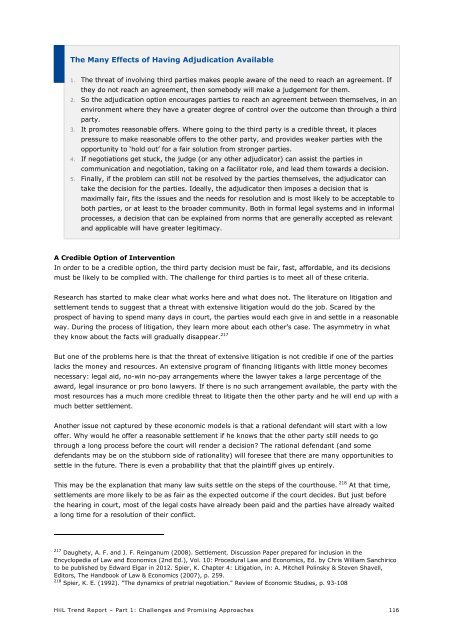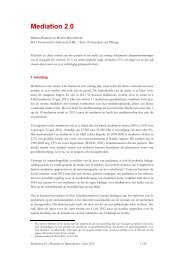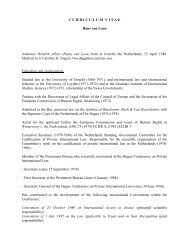Trend Report | Part 1 - HiiL
Trend Report | Part 1 - HiiL
Trend Report | Part 1 - HiiL
Create successful ePaper yourself
Turn your PDF publications into a flip-book with our unique Google optimized e-Paper software.
The Many Effects of Having Adjudication Available<br />
1. The threat of involving third parties makes people aware of the need to reach an agreement. If<br />
they do not reach an agreement, then somebody will make a judgement for them.<br />
2. So the adjudication option encourages parties to reach an agreement between themselves, in an<br />
environment where they have a greater degree of control over the outcome than through a third<br />
party.<br />
3. It promotes reasonable offers. Where going to the third party is a credible threat, it places<br />
pressure to make reasonable offers to the other party, and provides weaker parties with the<br />
opportunity to ‘hold out’ for a fair solution from stronger parties.<br />
4. If negotiations get stuck, the judge (or any other adjudicator) can assist the parties in<br />
communication and negotiation, taking on a facilitator role, and lead them towards a decision.<br />
5. Finally, if the problem can still not be resolved by the parties themselves, the adjudicator can<br />
take the decision for the parties. Ideally, the adjudicator then imposes a decision that is<br />
maximally fair, fits the issues and the needs for resolution and is most likely to be acceptable to<br />
both parties, or at least to the broader community. Both in formal legal systems and in informal<br />
processes, a decision that can be explained from norms that are generally accepted as relevant<br />
and applicable will have greater legitimacy.<br />
A Credible Option of Intervention<br />
In order to be a credible option, the third party decision must be fair, fast, affordable, and its decisions<br />
must be likely to be complied with. The challenge for third parties is to meet all of these criteria.<br />
Research has started to make clear what works here and what does not. The literature on litigation and<br />
settlement tends to suggest that a threat with extensive litigation would do the job. Scared by the<br />
prospect of having to spend many days in court, the parties would each give in and settle in a reasonable<br />
way. During the process of litigation, they learn more about each other’s case. The asymmetry in what<br />
they know about the facts will gradually disappear. 217<br />
But one of the problems here is that the threat of extensive litigation is not credible if one of the parties<br />
lacks the money and resources. An extensive program of financing litigants with little money becomes<br />
necessary: legal aid, no-win no-pay arrangements where the lawyer takes a large percentage of the<br />
award, legal insurance or pro bono lawyers. If there is no such arrangement available, the party with the<br />
most resources has a much more credible threat to litigate then the other party and he will end up with a<br />
much better settlement.<br />
Another issue not captured by these economic models is that a rational defendant will start with a low<br />
offer. Why would he offer a reasonable settlement if he knows that the other party still needs to go<br />
through a long process before the court will render a decision? The rational defendant (and some<br />
defendants may be on the stubborn side of rationality) will foresee that there are many opportunities to<br />
settle in the future. There is even a probability that that the plaintiff gives up entirely.<br />
This may be the explanation that many law suits settle on the steps of the courthouse. 218 At that time,<br />
settlements are more likely to be as fair as the expected outcome if the court decides. But just before<br />
the hearing in court, most of the legal costs have already been paid and the parties have already waited<br />
a long time for a resolution of their conflict.<br />
217 Daughety, A. F. and J. F. Reinganum (2008). Settlement. Discussion Paper prepared for inclusion in the<br />
Encyclopedia of Law and Economics (2nd Ed.), Vol. 10: Procedural Law and Economics, Ed. by Chris William Sanchirico<br />
to be published by Edward Elgar in 2012. Spier, K. Chapter 4: Litigation, in: A. Mitchell Polinsky & Steven Shavell,<br />
Editors, The Handbook of Law & Economics (2007), p. 259.<br />
218 Spier, K. E. (1992). "The dynamics of pretrial negotiation." Review of Economic Studies, p. 93-108<br />
<strong>HiiL</strong> <strong>Trend</strong> <strong>Report</strong> – <strong>Part</strong> 1: Challenges and Promising Approaches 116













